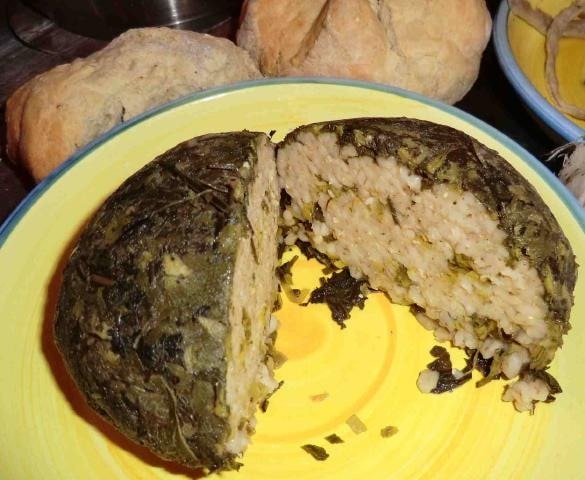In the world of food, there is a wide range of cuisines, from spicy to sweet, from local to international in scope. There are also many different cooking techniques and recipes; some are meant for special occasions, and others are meant for everyday use.
The common factor in these varying cuisines, however, is that they all have their own unique methods of preparation as well as their own unique era of origin.
Even within the same country or region, there will often be great differences in the types of food people enjoy. Some people favor local cuisine, while others prefer fast food restaurants with menus that can be eaten on-the-go.
If you ever find yourself curious about what eating habits were like a long time ago, here is a look at the eight oldest recipes in the world.
8. Linzer Torte
Year Invented: 1653
Country of Origin: Austria
Main Ingredients: Flour, hazelnuts, eggs, vanilla, sugar

A linzer torte is a type of Austrian pastry that originated in the city of Linz. It is a popular dessert in Austria and Central Europe and consists of a shortcrust pastry base with a fruit jam filling, usually raspberry. The pastry is typically decorated with a lattice top and dusted with icing sugar.
The earliest known recipe for Linzer Torte dates back to 1653 and was published in a cookbook called “Kochbuch für die Frauen” (Cookbook for the Women). The recipe was quite different from the Linzer Torte we know today, as it did not contain any fruit filling or topping. In the early 1800s, the Linzer Torte began to take on its modern form, with the addition of raspberry jam and a lattice top.
Today, Linzer Torte is a popular dessert served during the Christmas season. It is also a popular choice for weddings and other special occasions. If you are looking for a unique and festive dessert to serve this holiday season, consider making a Linzer Torte!
Did You Know?
There are many different variations of Linzer Torte, but the most common ingredients are ground almonds, sugar, cinnamon, butter, and flour; it can also be made with other fruit jams, such as apricot or blackberry.
7. Adobo
Year Invented: 1613
Country of Origin: Philippines
Main Ingredients: Chicken or pork, vinegar, soy sauce

Adobo is a traditional dish from the Philippines that typically consists of chicken or pork stewed in a vinegar and soy sauce base. It is believed to have originated in the Philippines, and it is often considered to be the country’s national dish.
On the one hand, it is said to have originated during the Spanish colonial period, when Filipino soldiers would cook their meat in this manner in order to preserve it.
Over time, the dish became a popular home-cooked meal, as it was both flavorful and inexpensive to make. Today, adobo can be found in many different variations, with different meats and seasonings being used. It remains a popular dish in the Philippines and is also enjoyed by many people around the world.
Did You Know?
The variety of adobo can get to more than a hundred versions depending on the region or province where it is cooked.
6. Frumenty
Year Invented: 1381
Country of Origin: UK
Main Ingredients: Eggs, almonds, currants, sugar, saffron and orange flower water

Frumenty is a type of medieval porridge made from boiled wheat. It was a popular dish in England and France during the Middle Ages, and is thought to have originated in either country. Frumenty was usually made with milk, honey, spices, and raisins, and was usually served as a dessert. I
t was also sometimes made with meat, and was then more like a stew.
Frumenty was a very popular dish during the medieval period, and was often served at feasts and banquets. It was also a popular food for Lent, as it was considered a fasting food.
There are many recipes for frumenty from the medieval period, and it is likely that each region had its own version of the dish.
Did You Know?
Today, frumenty is not as well known, but it is still possible to find recipes for it. It is sometimes served as a Christmas or New Year’s dish in England and is also popular in parts of France.
5. Hangover Cure Stew (Haejang-guk)
Year Invented: 900 CE
Country of Origin: South Korea
Main Ingredients: Cabbage, vegetables and meat in a hearty beef broth

Hangover cure stew was invented in South Korea in the early 900 CE. It is a type of soup that is traditionally made with beef, vegetables, and a variety of herbs and spices. The soup is said to be effective in treating the symptoms of a hangover, such as headaches, nausea, and fatigue.
There are a number of different recipes for hangover cure stew, but the basic ingredients usually remain the same. The soup is typically served hot, and it can be either thick or thin, depending on personal preference.
Some people also add a bit of alcohol to the soup, such as bourbon or brandy, which is said to further help with the symptoms of a hangover.
Did You Know?
Hangover cure stew is also a popular dish in the United States, and it is also commonly found in other countries, such as Canada, Mexico, and the United Kingdom.
4. Roast Boar
Year Invented: 4th-5th Century CE
Country of Origin: Central China
Main Ingredients: Pig or wild boar, seasonings, herbs for marination

The history of roasted boar stretches back to ancient times, with the dish appearing in various cultures across the world. While its exact origins are unknown, it is thought that roasted boar was first invented in Europe or Asia, particularly in China.
One of the earliest references to roasted boar can be found in the Roman cookbook Apicius, which dates back to the 1st century AD. The book includes a recipe for wild boar roasted with bay leaves, vinegar, and honey. This suggests that roasted boar was a popular dish in Roman times.
In medieval Europe, roasted boar was often served as a feast dish for special occasions. It was often cooked with garlic and herbs and served with a sweet sauce made from fruit or wine. Today, roasted boar is still enjoyed in many parts of the world.
It is often served as a traditional dish in Italy, Spain, and France. In Asia, roasted boar is a popular dish in China, Korea, and Japan, especially in the Philippines, where they call it lechon.
Did You Know?
Roast boar is typically made by slow-roasting a whole pig over an open fire. This cooking method helps to tenderize the meat and gives it a unique flavor. The boar is often served with a variety of accompaniments, such as potatoes, vegetables, and sauces.
3. Meat Pie
Year Invented: 1700 BCE
Country of Origin: Greece
Main Ingredients: Butter, flour, beef

The meat pie is a dish that has been around for centuries, with its origins dating back to the Middle Ages. It is believed that the first meat pies were created in ancient Greece, and they quickly became a popular food item among the working class.
The pies were typically made with a beef or mutton filling, and they were often served as a quick and easy meal.
Today, meat pies are enjoyed all over the world, and they come in a variety of different flavors and styles. In Australia and New Zealand, the pies are often served with a thick gravy, while in Canada and the United States, they are typically served with a flaky pastry crust.
No matter how they are served, meat pies are a delicious and hearty dish that is sure to satisfy.
Did You Know?
The pies became popular in America during the Revolutionary War, when British soldiers introduced them to the colonists. Today, meat pies are enjoyed all over the world and come in many different varieties.
2. Beer
Year Invented: Around 3400-2900 BCE
Country of Origin: Ancient Mesopotamia (Iraq, Kuwait, Turkey and Syria)
Main Ingredients: Water, malted barley, yeast, flavoring

The history of beer is a long and complicated one, with evidence of its existence dating back to ancient times. The first recorded instance of beer brewing is believed to have occurred in Mesopotamia around 3400 BC.
This early version of beer was made from a fermented beverage called “bappir” that was made from barley, water, and dates.
The Sumerians, who lived in Mesopotamia, were the first to write about beer, and they had a goddess of beer named Ninkasi. The ancient Egyptians also had a goddess of beer named Hathor, and beer was an important part of Egyptian culture.
It was often used as a form of currency, and it was even used as a burial offering for Pharaohs. The first evidence of beer brewing in Europe comes from the Celts, who inhabited present-day France, Belgium, and parts of Germany and Switzerland.
The Celts brewed a beer called “bragget,” which was made from honey, herbs, and spices.
Did You Know?
Beer brewing continued to spread throughout Europe, and by the Middle Ages, there were hundreds of different types of beer being produced.
1. Nettle Pudding
Year Invented: 6000 BCE
Country of Origin: UK
Main Ingredients: Sorrel, watercress, dandelion leaves, nettle leaves, flour, chives

Nettle pudding dates back to 6000 BCE in Britain and is considered the oldest known recipe in the world. It is a very thick, light mousse-like dessert made from nettles, milk, and eggs. In the 18th century, nettle pudding was a staple of the English diet.
It was thought to help with digestion and strengthen the heart. Nettles were also believed to have medicinal properties because they were known to be rich in iron.
Nettle pudding has been popular for centuries, although it wasn’t until recently that we learned how nutritious it actually is! Nettles are packed with vitamin C, iron, and magnesium—all nutrients that are beneficial for your health.
Did You Know?
Nettle pudding is prepared by boiling nettles in water until they are soft, then blending them with flour in a food processor (or by hand). The resulting batter is then poured into a baking pan and baked until it’s ready to be eaten!











